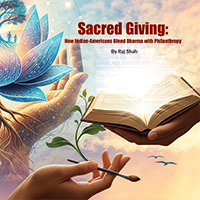Sacred Giving: How Indian-Americans Blend Dharma with Philanthropy
By Raj Shah
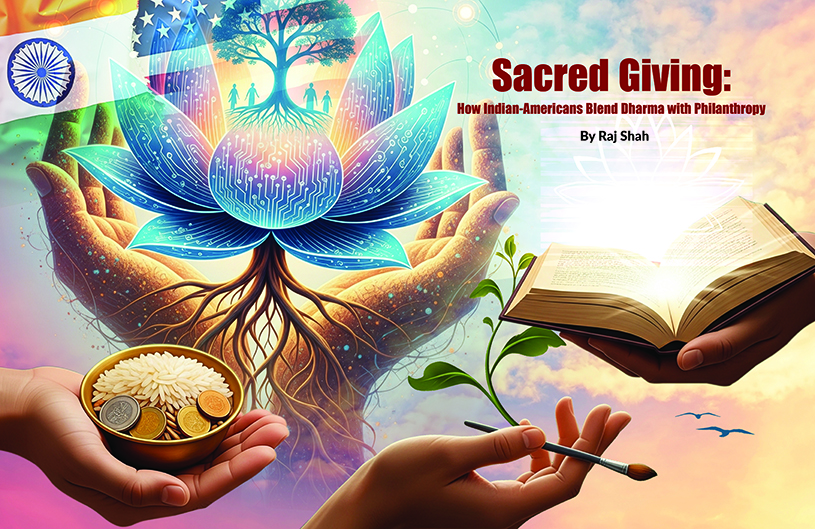
Long before organized philanthropy became a global phenomenon, the act of giving—dāna (donation) and seva (selfless service)—was enshrined in the spiritual DNA of Indian civilization. These principles, central to Hindu philosophy and deeply embedded in ancient Hindu scriptures, continue to shape the worldview and values of Indian-Americans today, especially as they rise to prominence in business, technology, medicine, and academia. For the Indian diaspora, particularly those in the United States, “giving back is not just a social duty—it is a sacred legacy”, a spiritual obligation, and a way to honor one’s roots while nurturing the society one inhabits.
Moreover, the principle of “Vasudhaiva Kutumbakam”—The world is one family,” from the Maha Upanishad, inspires many Indian-American philanthropists to expand their vision beyond national boundaries. This is why many Indian-American donors today contribute not just to causes in India, but also to underserved communities in the U.S., Africa, and Latin America.
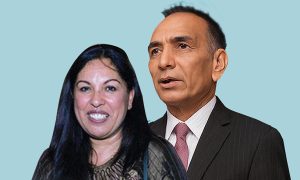 The story of Indian-Americans in the United States is a vibrant tapestry woven with threads of ambition, resilience, cultural heritage, and a deep-seated commitment to giving back. From their initial arrival as students and professionals to their present-day prominence across various sectors, Indian-Americans have not only achieved remarkable economic success but have also emerged as a significant force in American philanthropy. Their approach to giving is often deeply rooted in the principles of dharma, the ancient Indian concept encompassing duty, righteousness, and cosmic order. This inherent understanding of selfless action and the interconnectedness of all beings has shaped a unique philanthropic landscape where personal success is intrinsically linked to the well-being of the community, both within their adopted homeland and in their ancestral land.
The story of Indian-Americans in the United States is a vibrant tapestry woven with threads of ambition, resilience, cultural heritage, and a deep-seated commitment to giving back. From their initial arrival as students and professionals to their present-day prominence across various sectors, Indian-Americans have not only achieved remarkable economic success but have also emerged as a significant force in American philanthropy. Their approach to giving is often deeply rooted in the principles of dharma, the ancient Indian concept encompassing duty, righteousness, and cosmic order. This inherent understanding of selfless action and the interconnectedness of all beings has shaped a unique philanthropic landscape where personal success is intrinsically linked to the well-being of the community, both within their adopted homeland and in their ancestral land.
Let us look into the multifaceted world of Indian-American philanthropy, exploring the motivations, the key players, and the diverse causes they champion. Let us examine how the tenets of dana (charity), seva (selfless service), and karma (action and consequence) intertwine with American philanthropic traditions, creating a powerful and evolving model of giving. Through the stories of prominent donors and philanthropists, we will illuminate the profound impact of this community on education, healthcare, social justice, arts and culture, and international development, demonstrating how their sacred giving is leaving an indelible mark on the fabric of American society and beyond.
The Philosophical Foundation: Dharma and the Spirit of Giving
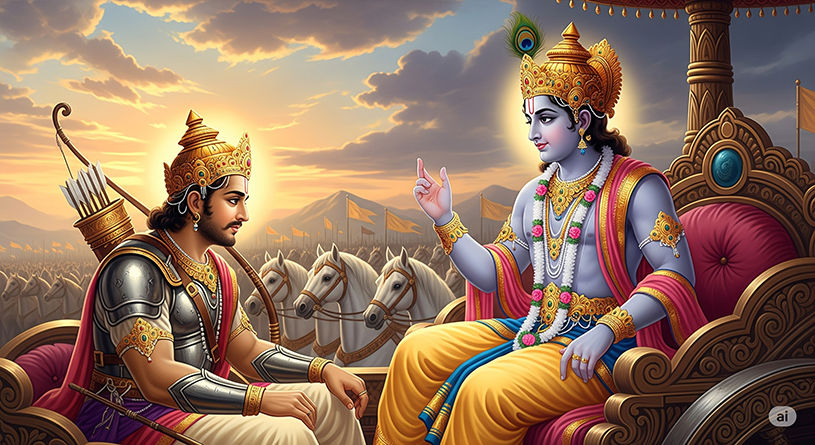 For many Indian-Americans, philanthropy is not merely an act of writing a check; it is an extension of their spiritual and ethical framework. The concept of dharma provides a profound impetus for giving, emphasizing the importance of fulfilling one’s duty to society and contributing to the common good. This inherent sense of responsibility transcends religious boundaries within the diverse Indian-American community, acting as a unifying principle that encourages selfless action.
For many Indian-Americans, philanthropy is not merely an act of writing a check; it is an extension of their spiritual and ethical framework. The concept of dharma provides a profound impetus for giving, emphasizing the importance of fulfilling one’s duty to society and contributing to the common good. This inherent sense of responsibility transcends religious boundaries within the diverse Indian-American community, acting as a unifying principle that encourages selfless action.
Central to this ethos is the principle of dana, often translated as charity or giving. In Hindu, Jain, Sikh, and Buddhist traditions, dana is considered a virtuous practice that purifies the giver and benefits the receiver. It is not just about material donations but also encompasses the giving of time, skills, and knowledge. This holistic understanding of giving is evident in the diverse ways Indian-Americans engage in philanthropic activities, from establishing large foundations to volunteering their expertise in community organizations.
Furthermore, the concept of seva, or selfless service, plays a crucial role in shaping philanthropic motivations. Seva emphasizes the importance of serving others without expectation of reward or recognition. This spirit of dedication and commitment is reflected in the hands-on involvement of many Indian-American philanthropists in the organizations they support, going beyond financial contributions to actively participate in their mission and impact.
The principle of karma, the law of cause and effect, also subtly influences philanthropic behavior. While not always a conscious driver, the understanding that one’s actions have consequences, both in this life and beyond, often motivates individuals to engage in positive actions that benefit others. Giving is seen as a way to accumulate positive karma and contribute to a more just and compassionate world.
The confluence of these deeply ingrained philosophical principles provides a strong moral compass for Indian-American philanthropy, guiding their decisions about where, how, and why they give. It imbues their giving with a sense of sacred duty, transforming it from a mere transaction into a meaningful expression of their values and beliefs.
In the Hindu tradition, dāna (दान)—voluntary and selfless giving—has always been considered one of the highest virtues. The Bhagavad Gita classifies dāna into three types: sāttvika dāna (pure and selfless), rājasika dāna (given with expectations), and tāmasika dāna (impure or harmful giving). Lord Krishna advises Arjuna in the Gita (17.20):
 “Dānam hi sāttvikam smritam — that gift which is given at the right place and time, to a worthy person, without expecting anything in return, is considered to be sāttvika (pure).”
“Dānam hi sāttvikam smritam — that gift which is given at the right place and time, to a worthy person, without expecting anything in return, is considered to be sāttvika (pure).”
This perspective reflects a profound understanding of giving—not as an act of superiority or generosity, but as a spiritual path of humility and detachment. The concept of seva, or selfless service, is also paramount. In the Bhagavata Purana, Mahabharata, and Upanishads, seva is lauded as a means to connect with the Divine through serving others—seeing God in all beings.
Even Chanakya, the legendary political strategist and philosopher, emphasized that wealth should be used for the welfare of society. In his Arthashastra, he noted:
“Kosha moolo dandah”—The treasury is the basis of governance. But its purpose is not hoarding—it is to uplift the people.
In fact, almost every major Hindu festival is accompanied by the act of dāna—from distributing food during Diwali or Navratri, to sponsoring public events, annadan (food donations), and educational causes during Guru Purnima or Makar Sankranti. Temples in India historically served not just as places of worship but as community centers—offering food, shelter, education, and medical care. The tradition of annadāna (free food service) has flourished for centuries in temples like Tirupati, Puri Jagannath, and the Golden Temple in Amritsar. These age-old customs, passed through generations, planted a culture of giving that has traveled with Indian immigrants across oceans and continents.
When Indians migrated to the United States in the mid-20th century, most arrived with limited resources but boundless ambition. As they gained success—particularly in engineering, medicine, IT, and entrepreneurship—the values of seva and dāna remained intact. Temples and cultural centers across the country—especially in the Southeast states like Florida, Georgia, and North Carolina—became the modern-day equivalents of ancient community mandirs, hosting health fairs, disaster relief drives, tutoring programs, and food pantries. These were not mere acts of charity but expressions of dharma (righteous duty).
The Rise of Indian-American Philanthropy: A Story of Success and Generosity
 The increasing prominence of Indian-Americans in philanthropy is closely linked to their remarkable success in various professional fields, particularly in technology, medicine, and business. Driven by a strong emphasis on education and hard work, the community has witnessed a significant rise in wealth creation over the past few decades. This economic prosperity has naturally led to a greater capacity and inclination to engage in philanthropic activities.
The increasing prominence of Indian-Americans in philanthropy is closely linked to their remarkable success in various professional fields, particularly in technology, medicine, and business. Driven by a strong emphasis on education and hard work, the community has witnessed a significant rise in wealth creation over the past few decades. This economic prosperity has naturally led to a greater capacity and inclination to engage in philanthropic activities.
The journey began with smaller, community-focused initiatives, often aimed at supporting educational and cultural organizations within the Indian-American community itself. As their financial success grew, so did the scale and scope of their giving. Many established foundations with broader missions, addressing issues both in the United States and in India.
Several factors have contributed to this burgeoning philanthropic landscape. The strong sense of community within the Indian-American diaspora fosters a culture of giving back, with successful individuals often feeling a responsibility to support those less fortunate. Moreover, the experience of immigration and the challenges often faced in a new country can cultivate empathy and a desire to help others overcome similar obstacles.
The intergenerational aspect of philanthropy is also becoming increasingly significant. As the first and second generations of Indian-Americans become more established, they are instilling the values of giving in their children, ensuring that philanthropy remains a core tenet of their family identity. This is leading to the emergence of multi-generational philanthropic endeavors with a long-term vision for creating positive change.
Furthermore, the increasing visibility and influence of Indian-Americans in American society have amplified their philanthropic impact. Their success stories inspire others within the community and beyond, encouraging a wider culture of giving. Their strategic approach to philanthropy, often leveraging their business acumen and entrepreneurial spirit, has also led to innovative and impactful initiatives.
Leading Lights: Profiles of Prominent Donors and Philanthropists
The Indian-American philanthropic landscape is illuminated by the contributions of numerous individuals and families who have demonstrated exceptional generosity and commitment to various causes. Their diverse backgrounds and philanthropic interests showcase the breadth and depth of giving within the community.
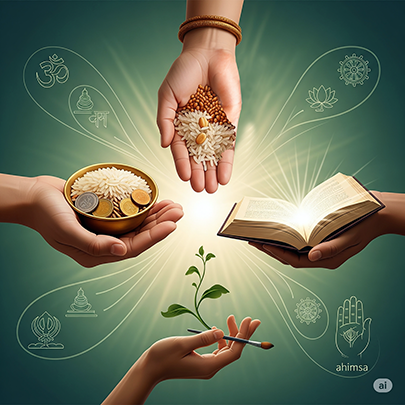 Dr. Kiran and Dr. Pallavi Patel: Their extraordinary commitment to healthcare and education has made a transformative impact. Their landmark contributions to Nova Southeastern University will shape the future of medical education and healthcare professionals. Their philanthropic vision extends beyond the United States, with significant investments in healthcare infrastructure and education in India and Africa, reflecting a global perspective on addressing critical human needs. Their establishment of cultural centers also highlights their dedication to preserving and promoting their heritage.
Dr. Kiran and Dr. Pallavi Patel: Their extraordinary commitment to healthcare and education has made a transformative impact. Their landmark contributions to Nova Southeastern University will shape the future of medical education and healthcare professionals. Their philanthropic vision extends beyond the United States, with significant investments in healthcare infrastructure and education in India and Africa, reflecting a global perspective on addressing critical human needs. Their establishment of cultural centers also highlights their dedication to preserving and promoting their heritage.
This husband-wife duo exemplifies the marriage of medicine and humanitarianism. Their record-breaking $200 million donation to Nova Southeastern University supported the expansion of its medical and public health programs. In India and Zambia, they’ve built hospitals, schools, and water purification facilities.
Kiran Patel believes in a “return on impact”—not for wealth, but for well-being. “We live in two worlds—our success must benefit both.”
Atal and Shaili Bansal, founders of Chetu Inc. and the Chetu Foundation, are prominent Indian-American philanthropists based in Florida, with charitable contributions exceeding $10 million. Through their foundation, they support a wide range of initiatives both in India and the U.S. Notably, they fund Akshaya Patra, which provides mid-day meals to schoolchildren in India, and contribute to rural school renovations. In the U.S., their giving focuses on children’s mental health programs, food distribution for underserved communities, scholarships, and digital learning kits. The Bansals are also deeply involved in local Florida community projects, including temple construction and youth mentorship.
Vinod and Neeru Khosla: Vinod Khosla, a pioneer in the technology industry, and his wife Neeru are signatories of the Giving Pledge, demonstrating their commitment to dedicating a significant portion of their wealth to philanthropic endeavors. Their giving is diverse, with a strong focus on education through initiatives like the CK-12 Foundation, which provides free and customizable educational content. They have also been significant contributors to disaster relief efforts, particularly in response to the COVID-19 pandemic in India. Their approach often reflects a desire to leverage innovation and technology to address pressing societal challenges.
Manoj Bhargava: The founder of Living Essentials, Manoj Bhargava, has taken a unique and impactful approach to philanthropy through his “Billions in Change” initiative and The Hans Foundation. His focus is on creating sustainable solutions to poverty and improving the lives of the less privileged, particularly in rural India. His initiatives encompass affordable healthcare, clean water, and sustainable energy solutions, often employing simple yet effective technologies. Bhargava’s philanthropy is characterized by a direct and hands-on approach, aiming to create tangible and lasting change at the grassroots level.
Romesh and Sunil Wadhwani: The Wadhwani brothers have made significant contributions to fostering entrepreneurship and improving livelihoods. Romesh Wadhwani, through the Wadhwani Foundation, focuses on creating jobs, developing skills, and accelerating economic development in India and other emerging economies. His initiatives support vocational training, small and medium enterprises, and innovation ecosystems. Sunil Wadhwani, through the WISH Foundation, is dedicated to improving healthcare access and delivery, particularly for underserved populations. Their philanthropic efforts leverage their business expertise to create sustainable and scalable solutions.
Bharat Desai and Neerja Sethi: The co-founders of Syntel have established the Desai Sethi Foundation with a focus on education, entrepreneurship, and rural development in both the United States and India. Their giving often supports scholarships, educational programs, and initiatives that empower individuals and communities to become self-sufficient. Their philanthropy reflects a deep commitment to fostering opportunities and addressing disparities in access to education and economic resources.
Desh and Jaishree Deshpande: Known for their entrepreneurial success in the technology sector, Desh and Jaishree Deshpande are deeply engaged in fostering social innovation and entrepreneurship through the Deshpande Foundation. Their approach emphasizes creating sustainable change by empowering local communities and supporting innovative solutions to social problems. They have been significant supporters of organizations like Akshaya Patra, which provides nutritious meals to millions of schoolchildren in India, and have also fostered entrepreneurial ecosystems in various regions.
Anna and Raj Asava: Through HungerMitao, they have successfully mobilized the Indian-American community to address the critical issue of food insecurity in the United States. Their model of leveraging community engagement and partnerships with food banks has proven to be highly effective in raising millions of meals for those in need. Their work exemplifies the power of collective action and the commitment of the Indian-American community to addressing social issues in their adopted homeland.
Prabhu and Poonam Goel: Their unwavering dedication to providing educational opportunities to deserving students in India through the Foundation for Excellence has transformed the lives of countless individuals and their families. By providing scholarships for professional degrees, they are empowering talented students from low-income backgrounds to achieve their full potential and contribute to India’s progress. Their long-term commitment to education reflects a deep belief in its power to break the cycle of poverty.
These are just a few examples of the many Indian-Americans who are making significant philanthropic contributions. Their diverse interests and approaches highlight the richness and complexity of giving within the community.
Beyond Individual Giving: Collective Impact and Community Initiatives
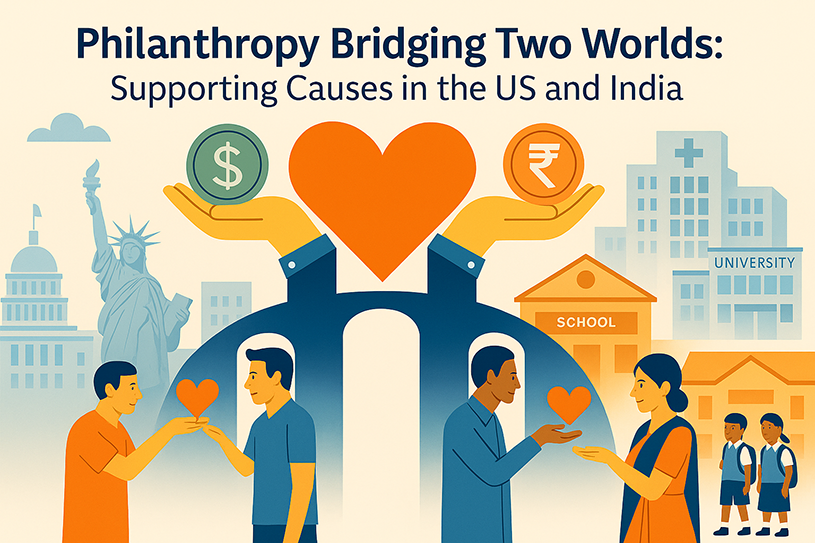 While individual philanthropists play a crucial role, the Indian-American community also demonstrates a strong tradition of collective giving and community-based initiatives. Numerous organizations and networks have been established to facilitate philanthropic engagement and address specific needs.
While individual philanthropists play a crucial role, the Indian-American community also demonstrates a strong tradition of collective giving and community-based initiatives. Numerous organizations and networks have been established to facilitate philanthropic engagement and address specific needs.
Religious and cultural organizations often serve as important hubs for charitable activities. Temples, mosques, gurdwaras, and community centers frequently organize fundraising events, support local charities, and provide assistance to community members in need. These institutions play a vital role in fostering a culture of giving and connecting individuals with opportunities to contribute.
Alumni networks of Indian educational institutions in the United States also engage in significant philanthropic activities, often focusing on supporting their alma maters and promoting education in India. These networks leverage the collective resources and connections of their members to make a meaningful impact on educational institutions and students.
Furthermore, professional organizations and industry associations within the Indian-American community often undertake philanthropic projects related to their respective fields. For example, medical associations may organize health camps and support healthcare initiatives, while technology associations may promote STEM education and entrepreneurship.
The rise of impact investing and venture philanthropy is also gaining traction within the Indian-American community, with individuals and foundations seeking to make investments that generate both social and financial returns. This innovative approach to philanthropy leverages business principles to address social and environmental challenges in a sustainable manner.
The collective philanthropic efforts of the Indian-American community, alongside the contributions of individual donors, amplify their overall impact and demonstrate a deep-rooted commitment to social responsibility.
Philanthropy Bridging Two Worlds: Supporting Causes in the US and India
A unique aspect of Indian-American philanthropy is its strong connection to both the United States and India. Many philanthropists divide their giving between causes in their adopted homeland and their ancestral land, reflecting a dual sense of belonging and responsibility.
In the United States, Indian-Americans support a wide range of causes, mirroring the diverse philanthropic landscape of the country. These include education, healthcare, poverty alleviation, social justice, arts and culture, and environmental conservation. Their contributions often reflect a desire to give back to the society that has provided them with opportunities and to address pressing social issues within their local communities and the nation as a whole.
Simultaneously, there is a strong tradition of supporting causes in India, addressing issues such as poverty, lack of access to education and healthcare, rural development, and disaster relief. Philanthropic efforts directed towards India often aim to leverage the donors’ understanding of the local context and cultural nuances to create effective and sustainable solutions. The deep emotional and cultural ties to their homeland often drive this commitment to giving back to India.
This dual focus on philanthropy in both the US and India highlights the interconnectedness of the world and the desire of Indian-Americans to make a positive impact on both their immediate communities and their global heritage. It also fosters cross-cultural exchange and collaboration in addressing shared challenges.
Challenges and the Future of Indian-American Philanthropy
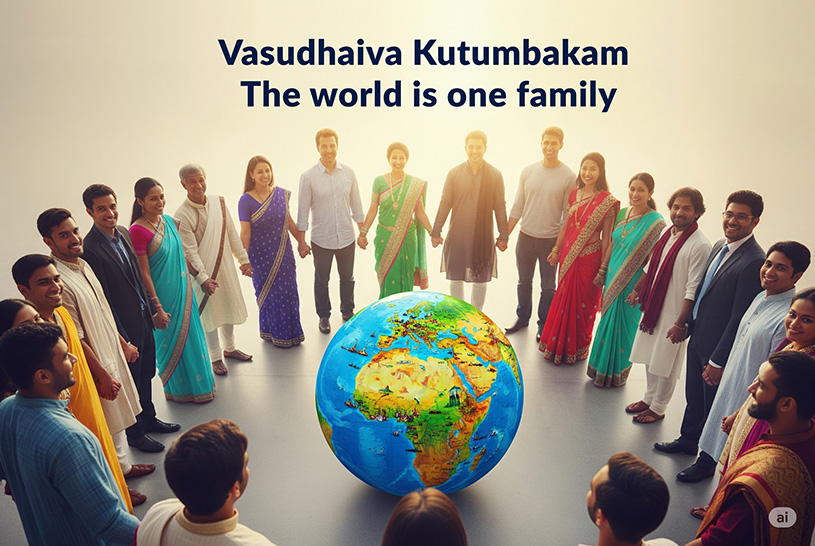 While Indian-American philanthropy has grown significantly, it also faces certain challenges. One challenge is the need for greater coordination and strategic alignment within the community’s philanthropic efforts to maximize impact. Fostering more collaboration among different organizations and individuals could lead to more effective and far-reaching outcomes.
While Indian-American philanthropy has grown significantly, it also faces certain challenges. One challenge is the need for greater coordination and strategic alignment within the community’s philanthropic efforts to maximize impact. Fostering more collaboration among different organizations and individuals could lead to more effective and far-reaching outcomes.
Another challenge is ensuring that philanthropic giving reflects the diversity of the Indian-American community and addresses the needs of all segments of society, both within the community and in the broader population.
Looking ahead, the future of Indian-American philanthropy holds immense potential. The increasing wealth and influence of the community, coupled with a growing awareness of social and environmental challenges, are likely to drive further philanthropic engagement. The next generation of Indian-Americans, often raised with a strong emphasis on social responsibility, is poised to play an even more significant role in shaping the philanthropic landscape.
The integration of technology and innovative approaches to giving, such as impact investing and crowdfunding, will likely further enhance the reach and effectiveness of Indian-American philanthropy. Moreover, a greater focus on measuring impact and ensuring accountability will be crucial in maximizing the positive outcomes of their giving.
A Legacy of Compassion and Contribution
Indian-Americans have woven a remarkable story of success and generosity in the United States. Their philanthropic endeavors, deeply rooted in the principles of dharma, dana, and seva, reflect a profound commitment to giving back and making a positive difference in the world. From supporting education and healthcare to fostering entrepreneurship and addressing social injustices, their contributions have had a significant impact both in their adopted homeland and in their ancestral land.
The stories of the prominent donors and philanthropists highlighted in this article serve as inspiring examples of the transformative power of sacred giving. Their dedication, vision, and unwavering commitment to serving others embody the best of both Indian and American values. As the Indian-American community continues to grow and thrive, their philanthropic spirit will undoubtedly continue to shape a more compassionate and equitable future for generations to come, leaving a lasting legacy of compassion and contribution. Their blend of dharma with philanthropy is not just a financial contribution; it is a sacred offering, a testament to their interconnectedness with the world and their enduring commitment to the well-being of all.
A Tradition of Dharma, A Future of Impact
What unites these givers—whether they write 8-figure checks or uplift one village at a time—is not just their wealth, but their worldview. Hindu scriptures teach that:
“Tyāga (renunciation) and Dāna (charity) purify the soul.” — Bhagavad Gita, 17.20
In a world driven by fame and fortune, these Indian-Americans remind us that true greatness lies in how many lives we touch, not how high we climb.
They are not just donors.
They are dharma warriors,
lighting up the world through their seva.
A Note to the Next Generation
To young Indian-Americans:
Let these stories inspire you not only to dream big, but to give big. Whether you’re starting your first job or your first startup, remember that giving is not what you do after success—it is the path to true success.
About the Author:
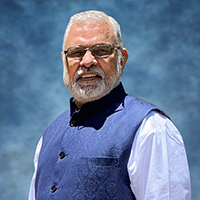
A software engineer by profession, Indian culture enthusiast, ardent promoter of hinduism, and a cancer survivor, Raj Shah is a managing editor of Desh-Videsh Magazine and co-founder of Desh Videsh Media Group. Promoting the rich culture and heritage of India and Hinduism has been his motto ever since he arrived in the US in 1969.
He has been instrumental in starting and promoting several community organizations such as the Indian Religious and Cultural Center and International Hindu University. Raj has written two books on Hinduism titled Chronology of Hinduism and Understanding Hinduism. He has also written several children books focusing on Hindu culture and religion.

